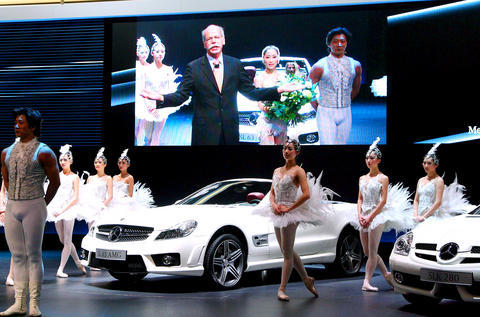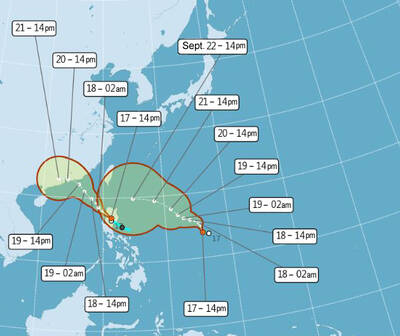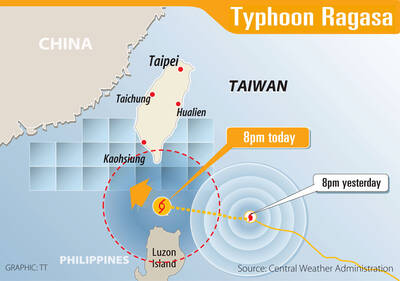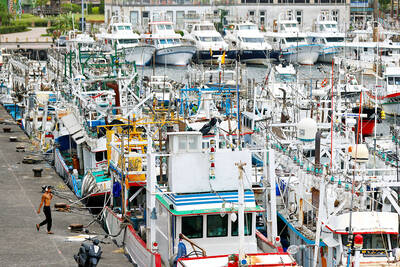General Motors Corp (GM) and Daimler AG unveiled plans on Tuesday for lithium-ion hybrids as automakers push to overcome difficulties with a technology that promises to push hybrid autos to the next level of performance.
Daimler AG will be the first to get to market, announcing plans to introduce a hybrid version of its Mercedes-Benz flagship S-class luxury sedan using a gasoline engine and a lithium-ion power source next year.
The new S-class is what is called a "mild" hybrid, meaning the electric motor aids combustion but does not itself drive the car, instead boosting the main engine. The new models will achieve a carbon dioxide emissions level of 190 grams per kilometer, higher than many small cars with efficient engines but which Daimler strategist Johannes Reifenrath said would make it the most efficient luxury car in the world.

PHOTO: EPA
To date, the least-emitting car in Mercedes' fleet is the diesel S-class with 230g/km.
The Mercedes example demonstrates the application of the technology at the luxury end of the market and is driven in part by tougher regulations taking effect in Europe in 2012 that would require automakers to reduce average emissions in their fleet to 130g/km.
"Change has to start now. Automakers can't wait until 2012," Reifenrath said.
General Motors said it expects to bring its first lithium-ion battery powered hybrid engine system to market in North America sometime in 2010. No product has been announced yet, but officials said the technology had potential across a broad range of product models.
GM showcased the technology in a Saab concept car, boasting carbon emissions of 117g/km on gas and 105g/km on ethanol. Unlike GM's other hybrid project -- the Volt, which has a large battery that can move the car by itself -- the new concept uses a smaller battery about the size of a case of soft drinks to assist the main internal-combustion motor.
The dual announcements indicated increased confidence in the technology, already widely used in consumer electronics. But adapting to meet demanding auto requirements has been an obstacle as has concerns about costs and overheating.
"I think there's a trend there. I think it is good news that Mercedes and GM are coming out at the same time," GM spokesman Scott Fosgard said.
GM is working with Hitachi, which has used a lithium-ion battery in an electric car, to develop its technology. GM's chief hybrid engineer, Stephen Poulos, said that the Hitachi battery design would give the GM application a degree of stability because it was easy to regulate the flow of energy -- but that tests were still being done to ensure stability to prevent overheating and the potential for fires.
"There are a lot of controls to make sure that doesn't happen," he said. "It is a more forgiving application of the lithium ion than most applications out there."
Because they are smaller yet more powerful than the nickel metal hydride batteries used in first-generation hybrid cars, like Toyota Motor Corp's Prius, lithium-ion technology holds the potential to be used across a wider range of models -- as Mercedes' launch of the technology in its powerful S class indicates.
GM chief executive officer Rick Wagoner said the company expected the technology to improve fuel economy by 20 percent. But he said to have a real impact, the technology must drive high volumes.
"The view is that the technology has the opportunity to get a much better range on a small battery and this has a chance to break through in a big way," Wagoner said.
GM said it expects hybrid sales volumes to exceed 100,000 vehicles per year. The system would build on GM's current hybrids, reducing engineering costs and the cost to consumers, the company said.
The battery system would be mated to a wide range of GM engines, including turbocharged gasoline, diesel and bio-fuel power plants. GM said in a statement that the new hybrid system would save fuel by turning the engine off at idle and cutting off fuel during deceleration. It would offer brief electric-only power, the company said in a statement.

One of two tropical depressions that formed off Taiwan yesterday morning could turn into a moderate typhoon by the weekend, the Central Weather Administration (CWA) said yesterday. Tropical Depression No. 21 formed at 8am about 1,850km off the southeast coast, CWA forecaster Lee Meng-hsuan (李孟軒) said. The weather system is expected to move northwest as it builds momentum, possibly intensifying this weekend into a typhoon, which would be called Mitag, Lee said. The radius of the storm is expected to reach almost 200km, she said. It is forecast to approach the southeast of Taiwan on Monday next week and pass through the Bashi Channel

WARNING: People in coastal areas need to beware of heavy swells and strong winds, and those in mountainous areas should brace for heavy rain, the CWA said The Central Weather Administration (CWA) yesterday issued sea and land warnings for Typhoon Ragasa, forecasting that it would continue to intensify and affect the nation the most today and tomorrow. People in Hualien and Taitung counties, and mountainous areas in Yilan and Pingtung counties, should brace for damage caused by extremely heavy rain brought by the typhoon’s outer rim, as it was upgraded to a super typhoon yesterday morning, the CWA said. As of 5:30pm yesterday, the storm’s center was about 630km southeast of Oluanpi (鵝鑾鼻), Taiwan’s southernmost tip, moving northwest at 21kph, and its maximum wind speed had reached

The Central Weather Administration (CWA) yesterday said that it expected to issue a sea warning for Typhoon Ragasa this morning and a land warning at night as it approached Taiwan. Ragasa intensified from a tropical storm into a typhoon at 8am yesterday, the CWA said, adding that at 2pm, it was about 1,110km east-southeast of Oluanpi (鵝鑾鼻), Taiwan’s southernmost tip. The typhoon was moving northwest at 13kph, with sustained winds of up to 119kph and gusts reaching 155kph, the CWA Web site showed. Forecaster Liu Pei-teng (劉沛滕) said that Ragasa was projected to strengthen as it neared the Bashi Channel, with its 200km

PUBLIC ANNOUNCEMENTS: Hualien and Taitung counties declared today a typhoon day, while schools and offices in parts of Kaohsiung and Pingtung counties are also to close Typhoon Ragasa was forecast to hit its peak strength and come closest to Taiwan from yesterday afternoon through today, the Central Weather Administration (CWA) said. Taiwan proper could be out of the typhoon’s radius by midday and the sea warning might be lifted tonight, it added. CWA senior weather specialist Wu Wan-hua (伍婉華) said that Ragasa’s radius had reached the Hengchun Peninsula by 11am yesterday and was expected to hit Taitung County and Kaohsiung by yesterday evening. Ragasa was forecast to move to Taiwan’s southern offshore areas last night and to its southwestern offshore areas early today, she added. As of 8pm last night,